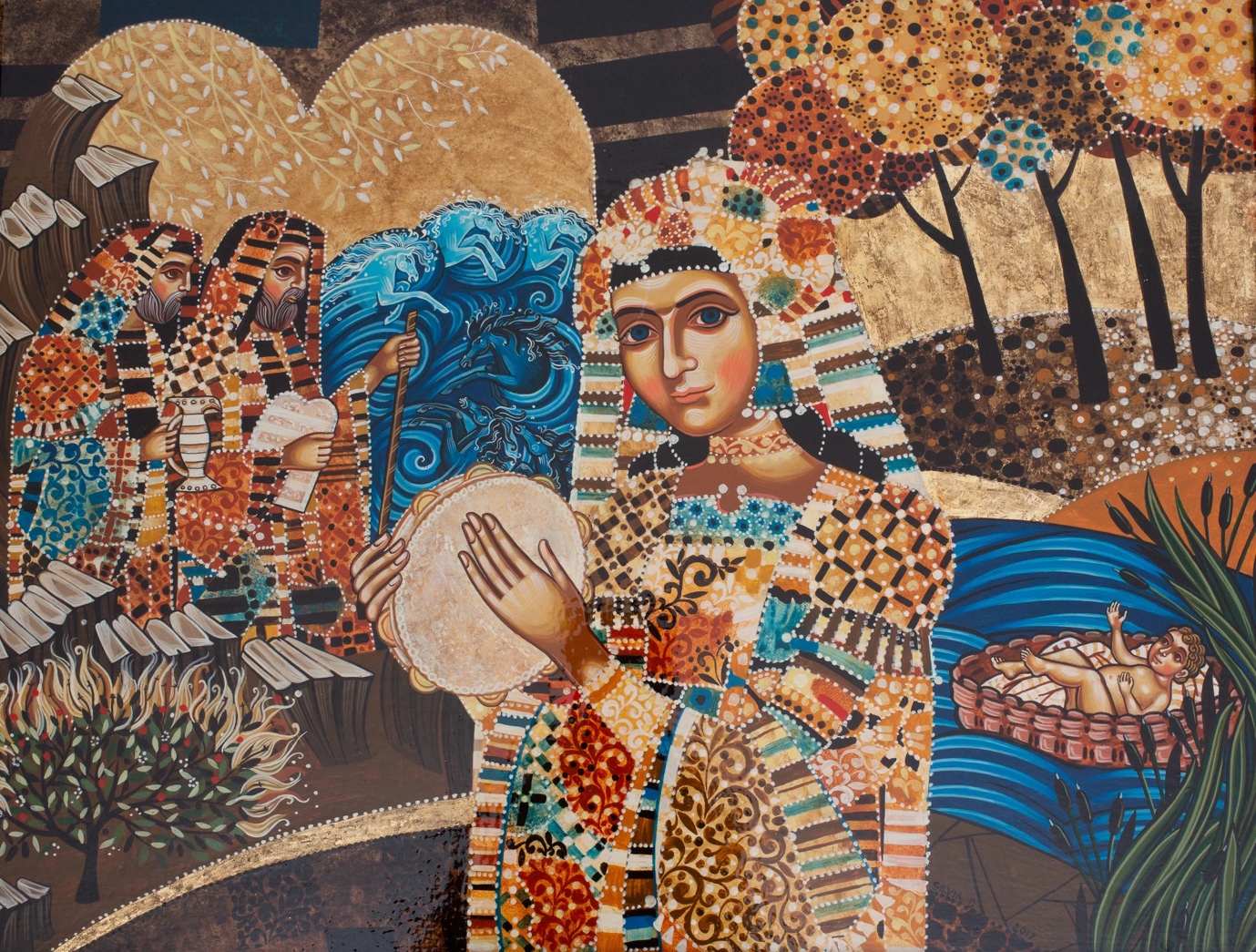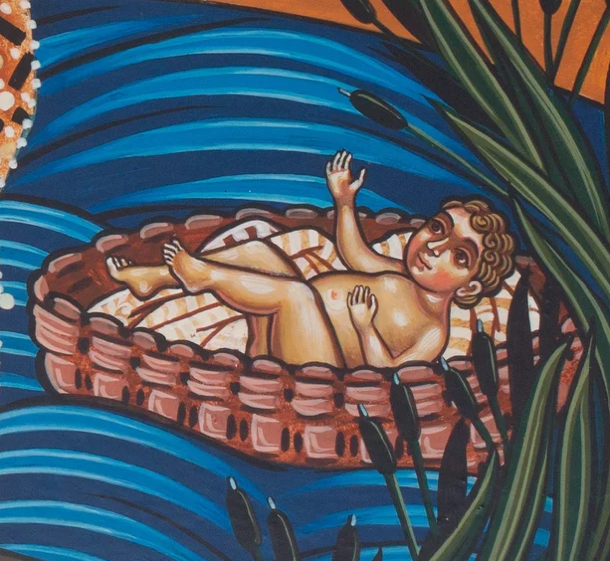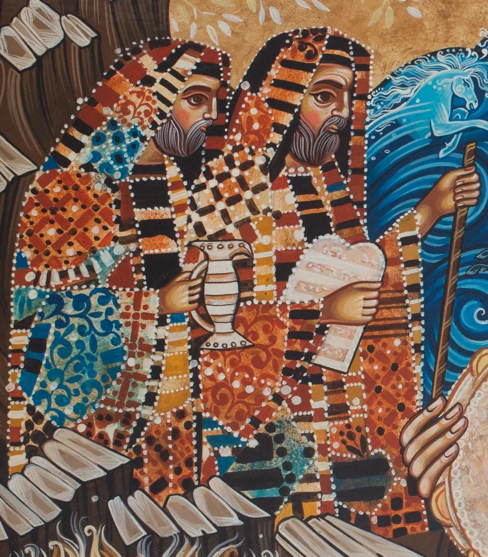Art and the Church -> Materials for Use in Churches



Exodus 15 - Miriam by Silvia Dimitrova
Silvia Dimitrova: Miriam

Crossing Over
by Otto Bam
Silvia Dimitrova’s Miriam stands front and centre, graceful, joyful. Her head is slightly tilted, recalling many traditional depictions of Mary, but instead of a baby, she holds a tambourine. The painting plunges us into many marvellous events from the book of Exodus. But the central moment is the crossing of the Red Sea. Exodus 15 tells of how Miriam led the people in joyful song: “Sing to the Lord, for he has triumphed gloriously; the horse and his rider he has thrown into the sea.” (Ex 15:21)
The painting is part of a series of seven paintings each depicting a woman from the Bible. The project started when Alison Kings, the wife of the Anglican bishop, theologian and poet Graham Kings, offered to buy him a commissioned work by Dimitrova as a 50th birthday present. The result was a painting of Mary Magdalene. Over the seventeen years that followed the bishop and the artist worked together to complete the series of seven women from the Bible.
Dimitrova, a trained orthodox icon writer and painter born in Pleven, Bulgaria, specialises in two modes of art –classical iconography and more modern paintings with secular subjects. The series of seven women, however, represents a unique blend of these two modes: biblical characters are depicted, but not according to the strict stipulations of iconography. Like an icon, the paintings are illustrative – they tell a story – and are full of symbolism, yet they offer a more personal expression of character which breaks with classical iconography. These are not icons, but they are iconic.
The painting of Miriam invites us to look deeper at the character of this extraordinary woman and the events in which she played such a pivotal role. Behind Miriam we see various events unfolding, almost as if her song becomes visible in the painting. Exodus calls Miriam a prophetess – it is through songs and poems that history is preserved in the memory of a people. Miriam’s song prophetically proclaims, calls to remembrance, and celebrates sacred history.
To the right among the bulrushes is the baby Moses, where he had been placed by his mother in an ark to save him from Pharaoh’s slaughter of Hebrew boys. We must not miss the irony in how Moses is saved from death. The Egyptians are commanded to kill boys born to the Israelite women by casting them into the Nile. But Moses’ mother devises a plan to preserve the boy’s life. She makes an ark and casts him, so to speak, into the very river that represents death to Israelite boys! To save him from death, Moses is delivered into the arms of death. This is a profound reflection and prefiguring of the Salvation that God would work in Christ, who by death defeats death.
Exodus relates how Miriam watches her brother to see what would become of him, and in a moment of astounding shrewdness, once Moses is discovered by Pharaoh’s daughter, Miriam convinces the Egyptian princess to have the baby nursed by his own mother! Miriam here emerges as a helper and protector, an invisible hand that orchestrates things for the preservation of her brother – a sort of midwife who sees to the deliverance of the baby from the water.

Look to the left of the painting and you will see Moses and Aaron. Below the two brothers is the burning bush. Moses, the Lawgiver, holds the tablets of the Law. Aaron, the high priest, holds a vase with anointing oil. The two men are walking towards the rushing waters of the parted Red Sea where they are soon to cross over.

The three adult figures in this painting form a sort of trinity. It is significant that the prophet Micah identifies all three these figures as the leaders of Israel out of Egypt: “I brought you up out of Egypt and redeemed you from the land of slavery. I sent Moses to lead you, also Aaron and Miriam” (Mic. 6:4). Might Miriam be considered a shadow of the Third Person of the Trinity? The One who, by an invisible hand, leads, guides and protects? The One who calls to remembrance the works of God?
Lent is a type of crossing over for Christians. We remember and identify with Christ in his crossing over – through baptism in the Jordan – into the wilderness for forty days, and ultimately through the baptism of death into glorious resurrected life. We enter into that wilderness by repentance, fasting, and prayer and by feeding on the Scriptures and the Sacrament. Miriam reminds us in profound ways that there is a powerful Helping Hand that accompanies us in all our crossings over and brings to remembrance the glorious works of God.
*******
Silvia Dimitrova Silvia was born in Pleven, Bulgaria in 1970 and won a place at the School of Applied Arts at Troyan at the age of 13. She graduated in 1989 and then studied icon painting in Sofia under the tuition of Georgi Tchouchev and was invited to exhibit her work in Alexander Nevsky Cathedral, Sofia, amongst the elite group of icon painters. She held a successful one-woman exhibition in Paris, in the Cultural Centre Edmond Rostand, Rueil-Malmaison in 1997. In the spring of 1999, she was commissioned by Downside Abbey to paint the Icon of St Benedict. At the beginning of 2000 Silvia worked as an artist-in-residence at Wells Cathedral with a commission to paint the Fourteen Stations of the Cross as a project for the Millennium. She was nominated and shortlisted for the European Women of Achievement Awards 2000 for contributions to the Arts. Since then Silvia has been working on both private and public commissions including St Paul's Cathedral, London and Hertford College, Oxford, Bishop's Palace, Wells and St Peter's, Eaton Square. See: http://www.silviadimitrova.co.uk
Nourishing Connections is collection of poetry which brings together Graham Kings’ poems on a range of devotional subjects, looking on the world with the eyes of faith and observing the sacred in the ordinary. With this perspective, all things are capable of pointing beyond themselves to the truth and beauty of God. The book contains seven poems reflecting on seven paintings by Silvia Dimitrova. Kings’ poetry celebrates the people, places, art, past and present, the practice of prayer, the stories that shape our lives, the rhythms of the spiritual year that have been for him doorways to the divine. See: https://www.grahamkings.org
The book led to the composition of seven anthems by the composer Tristan Latchford.
Otto Bam is a South African writer and musician. He is the co-editor of ArtWay and the arts manager for the Kirby Laing Centre for Public Theology, where he also holds a fellowship. Otto has a master’s degree in English Studies from Stellenbosch University, South Africa, as well as master’s degree in religion and literature from the University of Edinburgh.
ArtWay Visual Meditation 18 February 2024


